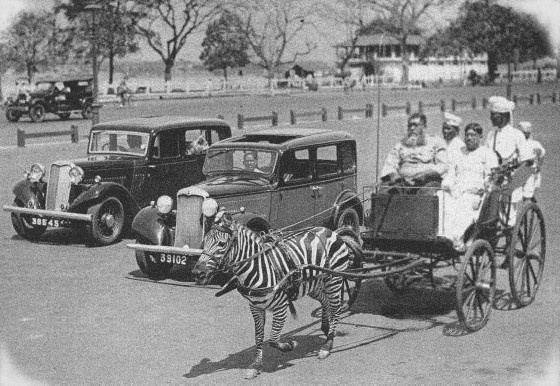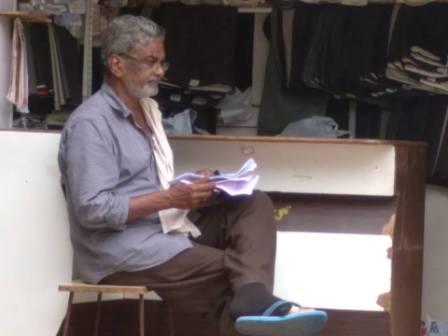Akshay Pathak
‘Aman ki Asha’, one of the many trendy Indo-Pak peace initiatives, could as well have been the title of a blockbuster from the Chopra brothers. Partition and Reunion as nostalgic themes in the savarna imagination seem tied in an inseparable bond, a sacred thread, to use a metaphor closer home. The piecing together of memory, of nostalgia, around these themes is similarly tied in with processes of power as has been evident in policies of the Indian state soon after the tragedy that followed the partition of Punjab.

Picture from the Lahore High Court, in pre-partition days
Of course, the mighty information machine, Google, realized the powerful potential of this nostalgia when it released an ad that became very popular a few years ago (https://www.youtube.com/watch?v=gHGDN9-oFJE). The ad weaves a story of a similar partition and reunion, garnished with copious amounts of sentimentality. It builds on half-a-century long narratives fuelled by successive governments, NGOs and many individuals who became celebrities in the process, arguably with their own lived or inherited legacies that compelled this re-construction.
The video is shot in perfectly manicured surroundings of plush homes, on either side of the border. The script and its onscreen treatment betray a lot of archival details like personal photographic documentation of pre-partition Punjab or how the photograph is placed in a diary of to-do lists with blurred names like Plumber Chamanlal. Not many can boast of this luxury, either of having been photographed back then, or having been able to carry it across the border on foot.
The protagonist is a curly-haired, fair-skinned, English-speaking (meritorious?) granddaughter who lives in Mumbai. With her easy hold over modern technology, this agential being enables a historic narrative.
It is the 21st century and wounds seem healed or almost getting there. The gently flowing curtains are crisp, regal antique furniture speaking of generations of opulence lines painted walls, presumably in some south Delhi mansion. Time is moving fast, only the taxi driver however is slow to get the grand daughter to the climactic moment of receiving the long lost friend from across the border, who is arriving from similar environments of crisp flowing curtains and balustrade-d bungalows. The story ends abruptly as they re-unite, sitting like young boys enjoying the monsoon rain amidst decorative potted palms in the inner courtyard of a ‘traditional’ huge bungalow. Thank you Google, for Mr. Mehra (another casual detail) and his friend Yusuf, owner of Fazal Sweets, the oldest sweet shop in Lahore (and now a chain), have managed to transcend all barriers of history and geography—with the magic wand of Google enabled search. It is perhaps a sense of closure? Can’t say, for the intricacies of the human mind and emotions operate in the speculative order.
However, what can move beyond speculation, after over half a century of the tragedy taking place, and an entire industry that was woven around it by a select class of savarnas, is that we have enough material to clinically examine, which could disturb this smooth narrative that has dominated popular representations.

Gaffar Market, which was allotted to Punjabi traders to set up shop
Take, for example, a lot of personal narratives heard in families or seen on-screen and how often they revolve around what had been left ‘back there’, what ‘was lost’, apart from trauma following loss and suffering (no less crucial or relevant, and no less intertwined with the structure one is part of), there were often very real material realities invoked – khet, khalihan, orchards, gold etc. The obvious contiguity of the social positions of those now indulging in this nostalgia of ‘back then’ with ‘here and now’ somehow didn’t strike a lot of us, in fact they were and are used to casually explain the ‘hard earned’ present. This nostalgia of the self-identified refugees, even after about 70 years and with a resettlement that is celebrated as an otherwise brutal state’s major achievement, is like the winter days of many a lavish homes in Jalandhar, Amritsar, Chandigarh, or Delhi, enveloped in thick fog, sanitizing a lot of details that hold immense potential to interrupt the after-party.
I grew up in a family that claimed a somewhat similar uninterrupted nostalgia.
The only grandparent who was alive by the time I was growing up was my grandmother, my father’s mother, Vidyawati (fondly called Motla), who with her curious eyes and a curt and chatty demeanour, regaled us with stories from her past soaked in unhealthy amounts of sugar and spice. She came from Lyallpur, what is now Faisalabad, to Jalandhar with my grandfather, who was then working in Lahore. He rode a bicycle to work (one of the many details she would just offer casually during her recollections). I can’t say with certainty if it were my own conflicting memories of how I pieced her many such narrations together, or perhaps, and I think this is truer, she was steadily ridding the recollections of sentimentality as she got older. My attempts to extract some past nostalgia, in fact, began to annoy her.
The childhood home, filled with fruit trees and a well and general festivity she used to tell us about, was gradually replaced with some anguished and unpleasant tales about the very backyard where they ate mangoes, in her later years. The bicycle, for her a symbol of struggling times made way for tales, from around the same time, of the stack of gold they sent with one of the relatives who left before August 1947 and who, now living in a big house somewhere in Chandigarh, never returned it, and many other such often contradictory revelations. She lived to a mighty age of 90 something (we didn’t really know her exact birth date). She passed away in August last year.
~
Utterly confused and curious with many of these puzzling stories, I ventured to look at these claims and started reading literature on partition – the many soppy novels, confusing personal accounts, dry academic studies, racialising analyses of the Ashis Nandy kind – all of which will inform the coming parts in this series. But it was in an account by the court historian of the Indian Empire, Mr Ramachandra Guha, that I chanced on a piece of information which further disrupted, or rather confirmed the lingering doubts over this hazy family (caste) nostalgia of people from my childhood and later years, compelling me to dig deeper into these narratives.

Punjabi Bagh, where mostly upper caste migrants found shelter
In his book India after Gandhi, while talking about the ‘massive task’ of land resettlement for the refugees, he recounts one particular incident that represents, arguably, one extreme of this nostalgia. He says:
The biggest single loser was a woman named Vidyawati who had inherited land (and lost) her husband’s estate of 11,500 acres spread across thirty-five villages of the Gujranwala and Sialkot districts. In compensation she was allotted a mere 835 acres in a single village of Karnal.
The ‘innovation’ implemented in resettlement of land and how the newly formed Indian state managed to achieve this bureaucratic feat should have been enough to set the alarm bells ringing. Instead we have laudatory accounts for the administrators working under Nehru by the likes of Mr Guha and scores of others. What emerges if one looks closely is that even in the aftermath of a tragedy as horrible as the partition, ‘independent’ India followed manu dharma and allotted land in east Punjab to the refugees based on their previous landholdings as clearly stated in the documentation of the Punjab government. (http://www.punjabrevenue.nic.in/land(1).htm). To answer which castes must have previously owned land in west Punjab or anywhere else in the subcontinent it should be common knowledge that caste and land are inextricably linked.
The government records further say that the land was ‘to be allocated to persons who were co-sharers in the same khewat or were descendants of the same grand-father and should be settled together in the same village or in the neighbouring villages.’ Further, ‘neighbours and families were resettled together, although the recreation of entire village communities proved impossible.’
Entire village communities might not have been possible to recreate but the caste order was patched up quite neatly together as would be evident today in cities like Jalandhar or Amritsar or even Delhi. If one were to do a simple caste census of the elite residential colonies and the Punjabi caste names of those claiming to be refugees, this recreation would reveal one of the major scams in Indian history. A student of history at Delhi University, Kartik Maini alerted me to something that one hopes is written about much more — the savarna domination of land and trade. He says: “We were allotted an entire residential-cum-commercial area in Sarojini Nagar. In the contemporary connotation of the word, we (if I can speak of/for Khatris) are not ‘refugees’ at all. But I do think that a remembrance of the Partition and many of its harrowing memories can be made while keeping the strength of the critique.”

Gujral house
And it was all done pretty fast. For example, just between early to end of December 1947, 210,000 families (mostly upper castes) were allotted around 2.4 million acres of land! This astounding ‘efficiency’ of a newly formed nation, unable to even contain the most horrid massacres taking place, yet ensuring this rather copious volume of paper work proceeding smoothly, remains suspect. Contrast this with how entire communities languish for years in camps after riots or natural disasters, even today.
Writer and Poet Gurinder Azad also recounts from his own research on the issue about how ‘Punjabi writer Balwant Gargi talked about M.S. Randhawa, the Deputy Commissioner in Delhi and the one in charge of resettlement, offered him a flat in the posh area of Hauz Khas. He was also the one who allotted land to Amrita Pritam, Gurbakhsh Singh Preet Ladhi (who made Preet Nagar in Amritsar) – all writers close to Randhawa – in Mehrauli.’ Such testimonies clearly offer evidences to help us understand and piece together these much-needed ‘material conceptions of history’.
This ‘recreation‘ in material terms needs to be seen in close relation to the creation of narratives and knowledge production around Partition studies by academics, writers, filmmakers etc., and the endless books and conferences with global funding, all dominated by a handful of caste clans is in dire need of a closer examination.
It isn’t far fetched to put this also in the context of Mr. Tharoor’s call for reparations at his celebrated Oxford speech and his now newly released book. Reparations, as the balance sheet of even this horrible tragedy would illustrate, need to be addressed in the light of the huge disparities that a complete socio-economic caste census data of this country would reveal.
~
The Google video that I mentioned in the beginning, put together by a crew of Sharmas, Mishras etc., isn’t a stand-alone specimen of this nostalgia industry. This investment in jingoistic nationalism (certainly not a product of the past few ‘fascist’ years), in order to strengthen the hegemonic idea of India has kept a contradiction of India vs. Pakistan alive. This also has been enabled, in large part, by constructing its imagined anti-thesis in a peace building, superficially reconciliatory cementing force as seen in the many such well funded initiatives. The Google ad came as just another, although more powerful, product of this manufacturing machine.
To locate it in the present context, at a time when an openly ‘right’ wing Hindu government displaying vulgar military machismo at regular intervals was marching towards the seat of power, one of the increasingly popular TV channels in many north Indian middle-class homes was something called Zindagi. It is full of weepy soap operas from ‘across the border’ which further cement this nostalgia of a feudal past, relished on flat screen comforts of perhaps an even more feudal present. My own parents spend most of their evenings watching these shows. The popularity of these shows would seem ironical, somewhat subversive too, given the overtly ‘Hindu’ discourse relished by both RSS and its so-called opponents in the mainstream media. Just that it is not. The shows are full of the same casteist, feudal narratives that strike a chord in the contiguous geography of caste that is this entire region. Add to that the cricket-matches and the surrounding noise and you have a wonderful example of how to conjugate ‘war’ with ‘aman ki asha’.

The average migrant’s first neighbourhood in India
The themes of reunion following such ruptured partition are heartening; they often offer hope and a sense of closure. I think my grandmother relished that reunion, in her head at least, in her recollections of the times gone by, of homes, places, people left behind, through the brutal forces of history. We all cherish similar nostalgia, provided that nostalgia speaks for us a better time, better place, or if it helps us rid of traumatic pasts. Nostalgia, as a co-passenger of history, however needs dispassionate scrutiny, as does history. This series sincerely hopes to do that.
(I would like to thank Anu Ramdas, Kuffir, James Michael and Pushpendra Johar for their valuable inputs.)
To be continued.
~~~
Akshay Pathak is a researcher and writer. He can be reached at pathak.akshay@gmail.com
Images: Google









